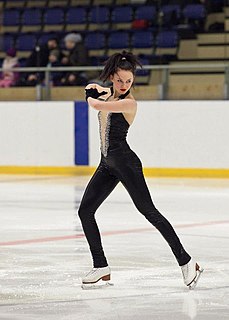
Susanna Pöykiö is a Finnish former figure skater. She is a two-time European medalist and a five-time Finnish national champion.
The Finlandia Trophy is a senior-level international figure skating competition. Since 1995, it is held annually in Finland in Greater Helsinki region, including Helsinki, Vantaa, and Espoo. It became part of the ISU Challenger Series in the 2014–15 season. Medals may be awarded in the disciplines of men's singles, ladies' singles, pair skating, ice dancing, and synchronized skating, although not every discipline is included every year.

The Nordic Championships are an annual elite figure skating competition. It was originally open only to representatives of Denmark, Finland, Iceland, Norway, and Sweden. Since 2011, representatives of any ISU member nation may enter the senior-level event, but not lower levels. Medals may be awarded on the senior, junior, and novice levels in men's singles, ladies' singles, pair skating, and ice dancing, although the latter two disciplines are often omitted due to lack of entries. Prominent Nordic champions include Olympic champions Gillis Grafström, Magda Julin, and Ludowika Jakobsson-Eilers / Walter Jakobsson.
The 2001 World Junior Figure Skating Championships were held from February 26 to March 2 at the Winter Sports Hall in Sofia, Bulgaria. Medals were awarded in men's singles, ladies' singles, pair skating, and ice dancing. Due to the large number of participants, the men's and ladies' qualifying groups were split into groups A and B.
The Finnish Figure Skating Championships are a figure skating national championship held annually by the Finnish Figure Skating Association to determine the national champions of Finland. Medals may be awarded in the disciplines of singles, pair skating, and ice dancing. Not all disciplines have been held in every year due to a lack of participants.
The 2007 Finlandia Trophy is an annual senior-level international figure skating competition held in Finland. It was held in Vantaa on October 12–14, 2007. Skaters competed in the disciplines of men's singles, ladies' singles, and pair skating. It was one of the competitions that helped choose the Finnish team for the 2008 European Figure Skating Championships.
The 2005 European Figure Skating Championships was a senior international figure skating competition in the 2004–05 season. Medals were awarded in the disciplines of men's singles, ladies' singles, pair skating, and ice dancing. The event was held at the Palavela in Turin, Italy from 25 January through 30, 2005.
The 2009 Finnish Figure Skating Championships took place between December 19 and 21, 2008 at the Helsingin jäähalli in Helsinki. Skaters competed in the disciplines of men's singles, ladies' singles, and ice dancing on the senior and junior levels. The results were one of the criteria used to choose the Finnish teams to the 2009 World Championships, the 2009 European Championships, and the 2009 World Junior Championships.
The 1998 World Figure Skating Championships were held in Minneapolis, USA from March 29 through April 5. Medals were awarded in the disciplines of men's singles, ladies' singles, pair skating, and ice dancing.
The 2010 Finnish Figure Skating Championships took place between December 18 and 20, 2009 at the Synergia-arena in Jyväskylä. Skaters competed in the disciplines of men's singles, ladies' singles, and ice dancing on the senior and junior levels. The results were one of the criteria used to choose the Finnish teams to the 2010 World Championships, the 2010 European Championships, and the 2010 World Junior Championships.
The 2003 Finnish Figure Skating Championships took place between January 10 and 12, 2003 in Turku. Skaters competed in the disciplines of men's singles, women's singles, pair skating, and ice dancing on the senior and junior levels. The event was used to help determine the Finnish team to the 2003 European Championships.
The 1998 Nordic Figure Skating Championships were held from February 27th through March 1st, 1998 in Helsinki, Finland. The competition was open to elite figure skaters from Nordic countries. Skaters competed in two disciplines, men's singles and ladies' singles, across two levels: senior (Olympic-level) and junior.
The 1999 Finnish Figure Skating Championships took place between December 11 and 13, 1998 in Joensuu. Skaters competed in the disciplines of men's singles, women's singles, and ice dancing on the senior and junior levels. The event was used to help determine the Finnish team to the 1999 European Championships.
The 2011 Finnish Figure Skating Championships took place between December 17 and 19, 2010 in Kupittaa of Turku. Skaters competed in the disciplines of men's singles, ladies' singles, and ice dancing on the senior and junior levels. The results were one of the criteria used to choose the Finnish teams to the 2011 World Championships, the 2011 European Championships, and the 2011 World Junior Championships.
The 2012 Finnish Figure Skating Championships took place between December 16 and 18, 2011 at the Tampereen Jäähalli in Tampere. Skaters competed in the disciplines of men's singles, ladies' singles, and ice dancing on the senior and junior levels. The results were one of the criteria used to choose the Finnish teams to the 2012 World Championships, 2012 European Championships, and 2012 World Junior Championships.
The 2013 Finnish Figure Skating Championships took place between December 14 and 16, 2012 in Joensuu. Skaters competed in the disciplines of men's singles, ladies' singles, and ice dancing on the senior and junior levels. The results were one of the criteria used to choose the Finnish teams to the 2013 World Championships, 2013 European Championships, and 2013 World Junior Championships.
The 2014 Finnish Figure Skating Championships took place between December 13 and 15, 2013 at the Barona Areena in Espoo. Skaters competed in the disciplines of men's singles, ladies' singles, and ice dancing on the senior and junior levels. The results were one of the criteria used to choose the Finnish teams to the 2014 Winter Olympics, 2014 World Championships, 2014 European Championships, and 2014 World Junior Championships.

The 2017 World Figure Skating Championships were held 29 March – 2 April 2017 in Helsinki, Finland. The host was named in June 2014. Medals were awarded in the disciplines of men's singles, ladies' singles, pairs, and ice dancing. The event also determined the number of entries for each country at the 2018 World Championships and the 2018 Winter Olympics.
The 2015 Finnish Figure Skating Championships took place between December 19 and 21, 2014 at the Trio Areena in Vantaa. Skaters competed in the disciplines of men's singles, ladies' singles, and ice dancing on the senior and junior levels. The results were one of the criteria used to choose the Finnish teams to the 2015 World Championships, 2015 European Championships, and 2015 World Junior Championships.
National figure skating championships of the 2017–2018 season are taking place mainly between December 2017 and January 2018. They are held to crown national champions and may serve as part of the selection process for international events such as the 2018 Winter Olympics and ISU Figure Skating Championships. Medals may be awarded in the disciplines of men's singles, ladies' singles, pair skating, and ice dancing. A few countries chose to organize their national championships together with their neighbors; the results were subsequently divided into national podiums.


